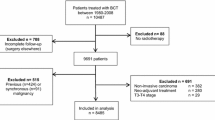Purpose:
We have retrospectively analyzed the impact of local recurrence in patients with adjuvant radiation therapy after mastectomy for breast cancer.
Patients and Methods: From January 1985 through December 1993, 959 patients were irradiated after mastectomy for breast cancer. The age ranged from 34 to 79 years, the median follow-up was 3.1 years (range: 0.3–12.2 years). 368 (38%) were pre- and 591 (62%) postmenopausal. 35% had T3–4-tumors, 62% had axillary lymph node involvement, and 66% received additional systemic hormonal and/or cytotoxic therapy. Postmastectomy radiotherapy was administered in case of positive axillary nodes and in high-risk pNO-patients. The chest wall and lymphatics (axilla, parasternal and supraclavicular nodes) were irradiated with an anterior photon field with 50 Gy and the chest wall with an electron field with 44 Gy in 2-Gy fractions.
Results: The overall survival was 70.5% after 5 and 59.8% after 10 years. 53 patients (5.5%) developed a locoregional recurrence lymph node involvement was the most important and (in a multivariate analysis the only) risk factor for local recurrence (p = 0.0001). Patients with local control had a significantly better 10-year distant-disease-free survival and overall survival as compared to patients with local recurrence (44.5% vs. 15.4%, p = 0.002 and 62.1% vs. 34.8%, p = 0.004). Local recurrence increased the risk of death by a factor of 1.7 and in a Cox regression model, axillary lymph node status, T-category and local recurrence were significant prognostic factors for overall survival. In patients with local recurrence, the initial axillary lymph node status was the most important prognostic factor for survival after local recurrence. The 3-year survival after local relapse was 86% for patients with pNO status vs 27% in with positive axillary nodes (p = 0.025).
Conclusions: Local recurrence after treatment of breast cancer with mastectomy + radiotherapy ± systemic therapy is associated with a significantly higher risk of distant metastases and death. In this analysis, local recurrence was a strong and, beside lymph node status and T category, an independent risk factor for survival. Minimizing the risk of local recurrence is therefore an essential goal of a curative treatment concept.
Hintergrund:
Wir haben in einer retrospektiven Analyse unseres Patientenkollektivs den Einfluss eines Lokalrezidivs auf die Prognose bei mastektomierten Mammakarzinompatientinnen untersucht.
Patienten und Methode: Von Januar 1985 bis Dezember 1993 erhielten 959 Patientinnen an unserer Klinik eine Bestrahlung nach Mastektomie in kurativer Intention. Das Alter betrug 34–79 Jahre. 368 (38%) waren prämenopausal, 35% hatten T3–4-Tumoren, und 62% wiesen einen axillären Lymphknotenbefall auf. Alle Patientinnen erhielten eine Bestrahlung der Thoraxwand und der regionären Lymphknoten (Axilla inklusive Supraklavikularregion und beidseitig parasternal) mit einer modifizierten Großfeldtechnik. Die Lymphknoten und laterale Thoraxwand wurden durch ein ventrales Stehfeld mit Telekobalt oder 9-MV-Photonen mit 50 Gy in Einzeldosen von täglich 2 Gy bestrahlt (RP in 2,5 cm Gewebetiefe); die Lunge wurde ausgeblendet und die Thoraxwand im Schatten dieses Absorbers mit einem individuell kollimierten Elektronenfeld mit 44 Gy in Einzeldosen von 2 Gy bestrahlt. 66% der Patientinnen erhielten eine zusätzliche Systemtherapie. Die Nachbeobachtungszeit betrug 3 Monate bis 12,2 Jahre (im Median 3,1 Jahre).
Ergebnisse: Die Gesamtüberlebensrate betrug 70,5% nach 5 und 59,8% nach 10 Jahren. 53 Patientinnen entwickelten ein Lokalrezidiv. Die rezidivfreie Zeit betrug 2–96 Monate (Median: 26 Monate). Die lokale Kontrollrate betrug 92,7% nach 5 und 86,4% nach 10 Jahren. Axillärer Lymphknotenbefall war (in multivariater Analyse) der einzige Risikofaktor für ein Lokalrezidiv (p = 0,0001). Patientinnen mit lokaler Kontrolle hatten im Vergleich zu Patientinnen mit Lokalrezidiv ein signifikant besseres fernmetastasenfreies Überleben (44,5% vs. 15,4% nach 10 Jahren, p = 0,002) und eine höhere Gesamtüberlebensrate (62,1% vs. 34,8% nach 10 Jahren, p = 0,004). Ein Lokalrezidiv erhöhte das Todesrisiko um den Faktor 1,7. In der Cox-Regression waren axillärer Lymphknotenbefall, T-Kategorie und das Auftreten eines lokalen Rezidivs unabhängige und signifikante Prognosefaktoren für das Gesamtüberleben. Bei Patientinnen mit Lokalrezidiv war der initiale axilläre Lymphknotenstatus der wichtigste Prognosefaktor für die Überlebenszeit nach dem Lokalrezidiv. Die 3-Jahres-Überlebensrate nach Lokalrezidiv betrug 86% für Patientinnen mit initialem pNO-Status vs. 27% für Patientinnen mit pN+, p = 0,025).
Schlussfolgerungen: Das Lokalrezidiv nach Mastektomie und postoperativer Radiotherapie ± Systemtherapie ist ein wichtiger und unabhängiger Prognosefaktor. Patientinnen mit Lokalrezidiv haben ein erhöhtes Risiko für Fernmetastasen und eine erhöhte Mortalität. Eine optimale lokale Kontrolle ist deshalb Grundlage eines kurativen Behandlungskonzepts.
Similar content being viewed by others
Author information
Authors and Affiliations
Additional information
Received: April 11, 2000; accepted: August 6, 2001
Rights and permissions
About this article
Cite this article
Dunst, J., Steil, B., Furch, S. et al. Prognostic Significance of Local Recurrence in Breast Cancer after Postmastectomy Radiotherapy. Strahlenther Onkol 177, 504–510 (2001). https://doi.org/10.1007/PL00002360
Issue Date:
DOI: https://doi.org/10.1007/PL00002360




